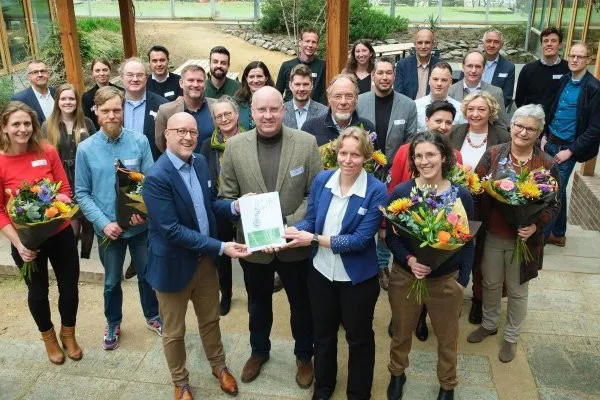There is an increasing need for reliable insight into the environmental impact of products. This is why Wageningen University & Research, together with Royal FloraHolland, has developed the FloriPEFCR for the floriculture sector. These Floricultural Product Environmental Footprint Category Rules enable you to calculate the environmental impact of cut flowers and potted plants using 16 environmental indicators. This calculation is done according to a European Commission-recognised Product Environmental Footprint standard, under which the FloriPEFCR falls. The FloriPEFCR should ensure that environmental impact in the floriculture sector can be compared and that false environmental claims can be prevented. With its publication on February 14, 2024, the FloriPEFCR is now the new standard method for environmental footprint calculations for flowers and plants.
 Guy Ackermans. Left to right: Jeroen Oudheusden (FSI), Albert Haasnoot (Royal FloraHolland) en Roline Broekema (projectleider Wageningen University & Research).
Guy Ackermans. Left to right: Jeroen Oudheusden (FSI), Albert Haasnoot (Royal FloraHolland) en Roline Broekema (projectleider Wageningen University & Research).
A strict manual was followed to develop this PEFCR. For example, a Technical Secretariat (TS) with at least 51% representation from the European sector must drive the process. Albert Haasnoot (Royal FloraHolland) is chairing this Technical Secretariat.
Next step
Now that the FloriPEFCR has been endorsed by the EC, Floriculture Sustainability Initiative (FSI) will start working on the verification of FloriPEFCR-compliant footprint tools that are already under development. With these footprint tools, the entire floriculture sector can get to work to realize the ultimate goal of the FloriPEFCR: to show in a fair and comparable way the environmental impact of a floriculture product and to reduce the impact of floriculture products.
FloriPEFCR history
In 2018, the project under the name 'Hortifootprint' was initiated by Royal FloraHolland, Fresh Produce Centre, and WUR. It was co-funded by the Dutch Ministry of Agriculture. The project group also includes Union Fleurs, MPS Group, Glastuinbouw Nederland, Natuur & Milieu, FSI, Florverde, ABN AMRO, and Rabobank. PRé Sustainability and Blonk Consultants provided LCA-specific support.
In 2019, following the publication of the Hortifootprint category rules, FloriPEFCR was further developed in the framework of the European Commission's Product Environmental Footprint. Under the policy proposed by the EU, companies making green claims will, in the future, be required to assess their products using Life Cycle Assessment-based methods. The so-called Product Environmental Footprint (PEF) method is specifically mentioned in this policy. The floriculture sector is leading the way with this.
Source: wur.nl
